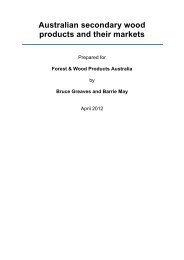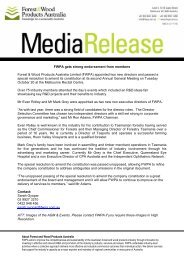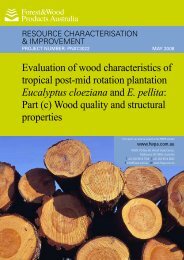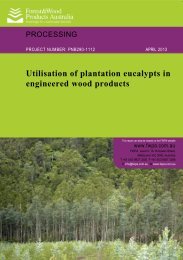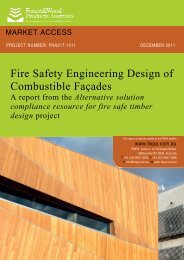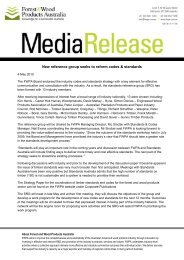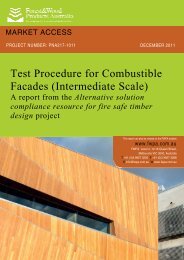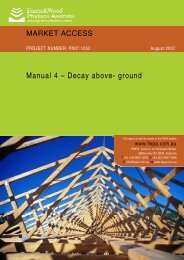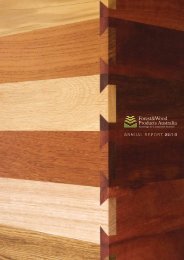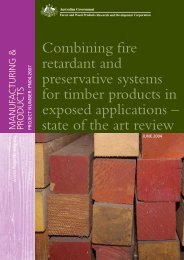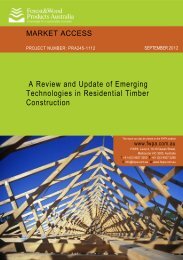guide to the specification, installation and use of preservative treated ...
guide to the specification, installation and use of preservative treated ...
guide to the specification, installation and use of preservative treated ...
Create successful ePaper yourself
Turn your PDF publications into a flip-book with our unique Google optimized e-Paper software.
GUIDE TO THE SPECIFICATION, INSTALLATION<br />
AND USE OF PRESERVATIVE TREATED<br />
ENGINEERED WOOD PRODUCTS<br />
EWPs have significant environmental advantages over o<strong>the</strong>r building materials such as concrete <strong>and</strong><br />
steel, beca<strong>use</strong> timber is a natural, renewable resource <strong>and</strong> has a low embodied energy <strong>and</strong> acts as a<br />
carbon s<strong>to</strong>re when <strong>use</strong>d in long term applications.<br />
EWPs currently available in Australia include gluedlaminated<br />
timber, laminated veneer lumber (LVL),<br />
plywood, oriented-str<strong>and</strong> board (OSB), particleboard<br />
<strong>and</strong> I-beams. O<strong>the</strong>r products such as parallel str<strong>and</strong><br />
lumber <strong>and</strong> laminated str<strong>and</strong> lumber are not<br />
generally available in Australia <strong>and</strong> are not within <strong>the</strong><br />
scope <strong>of</strong> this document, but <strong>the</strong> good practices<br />
outlined in this <strong>guide</strong> may be considered equally<br />
applicable. Each <strong>of</strong> <strong>the</strong> EWPs are briefly described<br />
as follows.<br />
Glued-laminated timber, or “Glulam”, is perhaps <strong>the</strong><br />
best known <strong>and</strong> longest established <strong>of</strong> <strong>the</strong> EWPs. It<br />
is generally formed in<strong>to</strong> a larger rectangular section<br />
by gluing <strong>to</strong>ge<strong>the</strong>r a number <strong>of</strong> selected <strong>and</strong><br />
prepared solid 20 <strong>to</strong> 50mm thick timber laminates.<br />
The grain <strong>of</strong> all laminates is aligned <strong>to</strong> <strong>the</strong><br />
longitudinal axes <strong>of</strong> <strong>the</strong> beam. Beams can be formed<br />
by ei<strong>the</strong>r st<strong>and</strong>ard “face” or “edge” lamination.<br />
Laminated veneer lumber, known as LVL, is formed<br />
by stacking <strong>and</strong> bonding <strong>to</strong>ge<strong>the</strong>r peeled or sliced<br />
veneers in<strong>to</strong> a thick panel. Individual veneers are up<br />
<strong>to</strong> 6mm thick with wood grain in successive veneers<br />
generally aligned in <strong>the</strong> direction <strong>of</strong> <strong>the</strong> beam<br />
longitudinal axis. The resulting long panel is <strong>the</strong>n cut Naturally durable hardwood<br />
in<strong>to</strong> structural beam-sized sections.<br />
Glulam <strong>and</strong> plywood sheathing<br />
(Courtesy Stephen Bolden)<br />
Plywood is formed by stacking <strong>and</strong> bonding <strong>to</strong>ge<strong>the</strong>r<br />
a number <strong>of</strong> thin veneers <strong>to</strong> form a sheet panel product. Individual veneers are up <strong>to</strong> 6mm thick <strong>and</strong><br />
<strong>the</strong> finished sheet up <strong>to</strong> 45mm thick. Successive veneers are laid at right angles <strong>to</strong> <strong>the</strong> previous one<br />
<strong>to</strong> form a panel with good strength in <strong>the</strong> sheet plane <strong>and</strong> good panel dimensional stability.<br />
Oriented-str<strong>and</strong> board, known as OSB, is formed in<strong>to</strong> a structural panel product by bonding <strong>to</strong>ge<strong>the</strong>r<br />
thin wood “str<strong>and</strong>s” with adhesive. Wood str<strong>and</strong>s are generally oriented with grain direction in <strong>the</strong><br />
major longitudinal direction in <strong>the</strong> outer layers <strong>and</strong> in <strong>the</strong> cross direction in <strong>the</strong> inner layers <strong>of</strong> <strong>the</strong><br />
sheet <strong>to</strong> provide panel dimensional stability.<br />
Particleboard is formed from a mat <strong>of</strong> individual wood particles which are coated in adhesive resin <strong>and</strong><br />
pressed <strong>to</strong>ge<strong>the</strong>r in<strong>to</strong> a finished panel. Wood fibres in <strong>the</strong> particles end up r<strong>and</strong>omly oriented in<br />
direction within <strong>the</strong> panel resulting in uniform properties in each direction.<br />
Treated LVL deck bearer<br />
(Courtesy CHH WoodProducts Australia)<br />
I-beams are prefabricated with solid timber or LVL<br />
flanges separated <strong>and</strong> glued in place using a wood<br />
panel web. The web is most commonly plywood or<br />
OSB. The resulting cross section is a structurally<br />
efficient “I” shape.<br />
Generic design properties <strong>of</strong> glued-laminated timber<br />
<strong>and</strong> plywood are provided in AS1720.1 Timber<br />
structures, Part 1: Design methods. Design<br />
properties for LVL, OSB, particleboard <strong>and</strong> I-beams<br />
are proprietary hence designers must specify <strong>the</strong>se<br />
products by name <strong>and</strong> refer <strong>to</strong> <strong>the</strong> manufacturer for<br />
relevant design properties.<br />
The general durability <strong>of</strong> EWPs is dependent on<br />
both durability <strong>of</strong> <strong>the</strong> timber components <strong>and</strong><br />
durability <strong>of</strong> adhesives <strong>use</strong>d <strong>to</strong> bond <strong>the</strong>m. Failure<br />
<strong>of</strong> ei<strong>the</strong>r <strong>the</strong> adhesive or wood, results in product<br />
Page | 7



